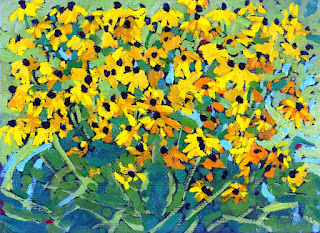Every fish shack seems to be somewhat unique. The structures are individuals like the fishermen who built them. They are architecturally designed to suit the peculiarities of that distinct portion of shoreline. Any large boulders are incorporated into the design. Those large boulders are called "leverites" for a good reason as they are simply too massive to move. The fishermen "leave them right there". The materials are certainly not extravagant and appear to be the most economical that will do the job.
The fish shacks always seemed so quiet and peaceful to me. The fishermen must have been busy but I never really caught them in the act. The timetable of a tourist is far more relaxed than that of a working fisherman. I think of this painting as a tribute to their individualistic life style in the face of pressures coming from all directions including the weather. The home on the road at the top of the ridge detracted from the simpler Fish Shacks so I buried it in the trees. That is artistic licence.
 |
Capture of the Atlantic northwest cod stock
in million tonnes,
with Canadian capture in blue
|
The career of a fisherman is so tied to the elements and the ocean. I see fishing is a very precarious occupation. Government bureaucracies and foreign fishing factory boats are not helpful to the small fisherman who completes his occupation more in tune with the fish and the environment. The cod fishery was predictably driven into extinction and it was not at the hand of the small costal fisherman. The Northern Cod biomass fell to 1% of earlier levels as noted in the summer of 1992. The cod fishery simply collapsed. There were no Wall Street Lawyers representing Joe Codfish. A moratorium on the Northern Cod fishery was at first meant to last two years. I believe the moratorium still continues in one fashion or another as I paint this tribute to Hackett's Cove and a way of life.
Apparently the major factor that contributed to the depletion of the cod stocks off the shores of Newfoundland was the introduction of equipment and technology that increased the volume of landed fish. From the 1950s onwards, new technology allowed fishermen to trawl a larger area, fish deeper, and for a longer time. By the 1960s, powerful trawlers equipped with radar, electronic navigation systems, and sonar allowed crews to pursue fish with unparalleled success. The Canadian catches peaked in the late1970s. Cod stocks were depleted at a faster rate than could be replenished. Trawlers caught enormous amounts of non-commercial fish as well. These other fish were economically unimportant but very important ecologically. This incidental catch undermined the ecosystem stability, depleting stocks of important predator and prey species.
Approximately 35,000 fishermen and fish plant workers lost their jobs due to the collapse of the cod fisheries, with devastating impact on the Newfoundland and other maritime communities. The collapse of the northern cod fishery marked a profound change in the ecological, economic and socio-cultural structure of Atlantic Canada. The moratorium in 1992 was the largest industrial closure in Canadian history.
 |
"Four Fish" by Paul Greenberg
|
The exploitation of the riches of the globe seems to know no bounds. Simple greed. "Four Fish", a book by Paul Greenberg details the sad story of exploitation and the decline of the worlds fishery. Nature needs representation at the bargaining table when the movers and shakers are diving up the shares and exploiting the riches of the environment. I figure if I am going to have an opinion, I wll do my very best to make it an informed one. I read a non-fiction to discover the facts so I can separate out the fiction from the lobbyists.
Oils on burnt sienna oil tinted commercial stretched canvas - 14 X 18 (inches) by 3/4 (0.750) inches in depth. The timing of this image would have been the spring of 1985 - before we moved back to Upper Canada in the summer of that year.
For this and much more art, click on Pixels. Thank you.










































